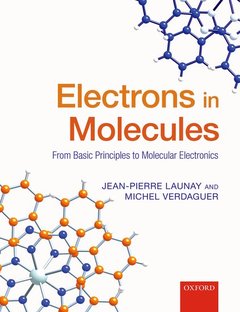Description
Electrons in Molecules
From Basic Principles to Molecular Electronics
Authors: Launay Jean-Pierre, Verdaguer Michel
Language: English
Subject for Electrons in Molecules:
Publication date: 10-2013
512 p. · 19.5x24.8 cm · Hardback
Out of Print
512 p. · 19.5x24.8 cm · Hardback
Out of Print
Description
/li>Biography
/li>
The purpose of this book is to provide the reader with essential keys to a unified understanding of the rapidly expanding field of molecular materials and devices: electronic structures and bonding, magnetic, electrical and photo-physical properties, and the mastering of electrons in molecular electronics. Chemists will discover how basic quantum concepts allow us to understand the relations between structures, electronic structures, and properties of molecular entities and assemblies, and to design new molecules and materials. Physicists and engineers will realize how the molecular world fits in with their need for systems flexible enough to check theories or provide original solutions to exciting new scientific and technological challenges. The non-specialist will find out how molecules behave in electronics at the most minute, sub-nanosize level. The comprehensive overview provided in this book is unique and will benefit undergraduate and graduate students in chemistry, materials science, and engineering, as well as researchers wanting a simple introduction to the world of molecular materials.
After studies at Ecole Normale Supérieure (ENS) de Saint-Cloud, Jean-Pierre Launay was Assistant Professor at Université Pierre et Marie Curie in Paris from 1967. His research was on the electrochemistry of polyoxoanions, and mixed valence systems. He was appointed Professor in 1983 and developed investigations on molecular electronics. In 1989, he moved to Toulouse, and led the "Centre for Materials Elaboration and Structural Studies", a CNRS laboratory, from 2003 to 2010. He has been a member of Institut Universitaire de France. He has also worked on molecular machines such as rotary motors and switching elements. He holds awards from the French Chemical Society and the French Academy of Sciences. Following a career as a secondary school teacher and Assistant Professor at Ecole Normale Supérieure (ENS) de Saint-Cloud, Michel Verdaguer became Professor at the Université Pierre et Marie Curie in Paris in 1988. His research endeavours concentrate on molecular magnetism, in which field he has developed a rational approach to new systems, from quantum chemistry to applications (Haldane's gap, high spin molecules, room-temperature magnets, single molecule magnets). He developed synchrotron radiation studies in the field of molecular materials. He led the "Inorganic Chemistry and Molecular Materials Laboratory", associated to CNRS, from 1994 to 2001. He is presently engaged in the study of molecular multifunctional magnetic materials. He holds awards from the Spanish and French chemical societies and from the French Academy of Sciences.
© 2024 LAVOISIER S.A.S.




